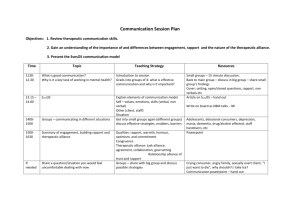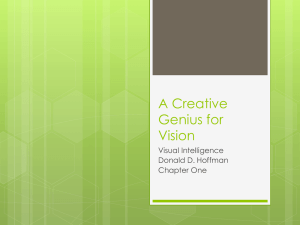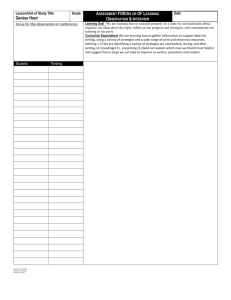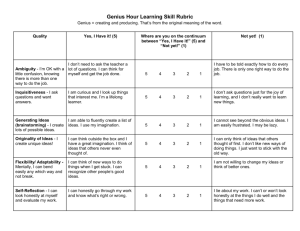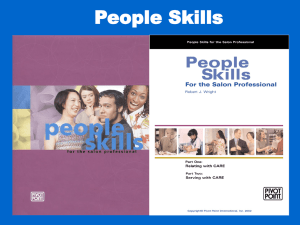Annotated Instructional Design Case Study
advertisement
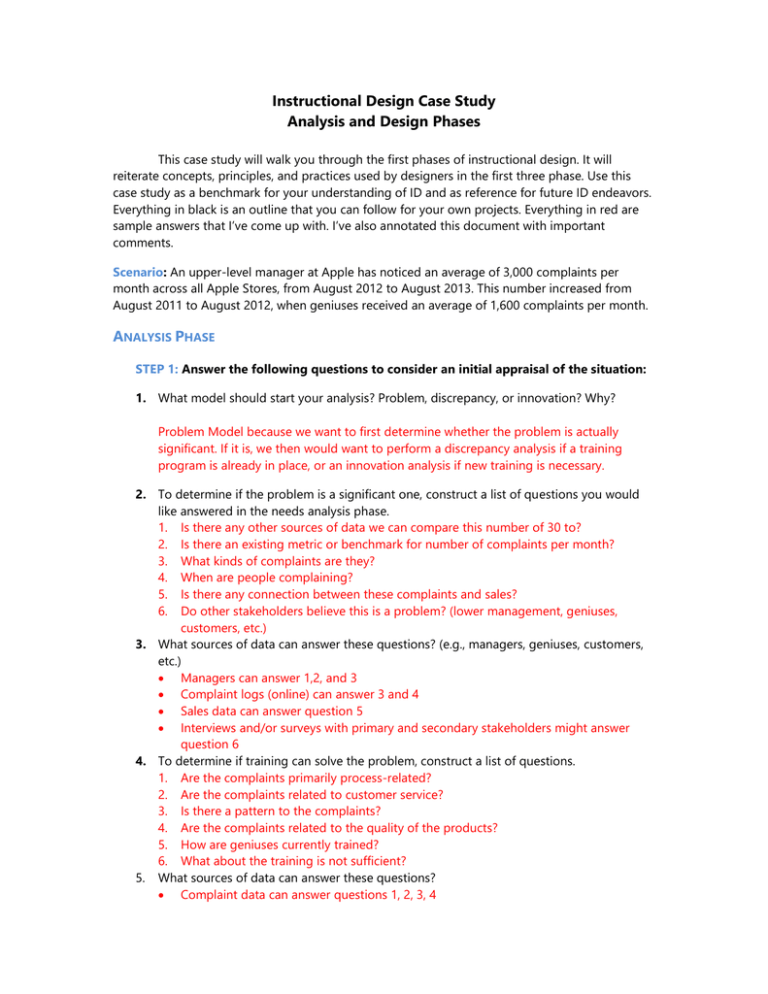
Instructional Design Case Study Analysis and Design Phases This case study will walk you through the first phases of instructional design. It will reiterate concepts, principles, and practices used by designers in the first three phase. Use this case study as a benchmark for your understanding of ID and as reference for future ID endeavors. Everything in black is an outline that you can follow for your own projects. Everything in red are sample answers that I’ve come up with. I’ve also annotated this document with important comments. Scenario: An upper-level manager at Apple has noticed an average of 3,000 complaints per month across all Apple Stores, from August 2012 to August 2013. This number increased from August 2011 to August 2012, when geniuses received an average of 1,600 complaints per month. ANALYSIS PHASE STEP 1: Answer the following questions to consider an initial appraisal of the situation: 1. What model should start your analysis? Problem, discrepancy, or innovation? Why? Problem Model because we want to first determine whether the problem is actually significant. If it is, we then would want to perform a discrepancy analysis if a training program is already in place, or an innovation analysis if new training is necessary. 2. To determine if the problem is a significant one, construct a list of questions you would like answered in the needs analysis phase. 1. Is there any other sources of data we can compare this number of 30 to? 2. Is there an existing metric or benchmark for number of complaints per month? 3. What kinds of complaints are they? 4. When are people complaining? 5. Is there any connection between these complaints and sales? 6. Do other stakeholders believe this is a problem? (lower management, geniuses, customers, etc.) 3. What sources of data can answer these questions? (e.g., managers, geniuses, customers, etc.) Managers can answer 1,2, and 3 Complaint logs (online) can answer 3 and 4 Sales data can answer question 5 Interviews and/or surveys with primary and secondary stakeholders might answer question 6 4. To determine if training can solve the problem, construct a list of questions. 1. Are the complaints primarily process-related? 2. Are the complaints related to customer service? 3. Is there a pattern to the complaints? 4. Are the complaints related to the quality of the products? 5. How are geniuses currently trained? 6. What about the training is not sufficient? 5. What sources of data can answer these questions? Complaint data can answer questions 1, 2, 3, 4 Management/HR can answer question 5 and 6 Customers can answer questions 5 and 6 Results Scenario: Based on the needs analysis, the following key results were found: 1. 2. 3. 65% of all complaints (23,500) were related in some way to interaction with a genius. a. 20% of these complaints were related to a negative customer service experience when interacting with genius. b. 20% of these complaints were related to unclear communication about product problems c. 60% of these complaints were related to long wait times. 20% of the complaints were due to Apple return and warranty policies. 15% of the complaints were due to the quality of products. STEP 2: Based on these results, answer the following questions: 1. 2. 3. Can training help manage these results? Why? Yes, I believe training can manage the results that were related to interaction w/ a genius. There seems to be a clear need related to how geniuses communicate with customers and the overall process itself. Who needs to be trained? Geniuses, store managers What general areas or topics should these stakeholders be trained in? Communicating and interacting with customers (relational) Communicating technical problems to customers Managing and staying on schedule for genius bar appointments STEP 3: Now write learning goals for your training program. 1. 2. 3. Genius bar workers will learn to build rapport with customers who have genius bar appointments. Genius bar workers will learn to explain and teach customers about technical problems in an easy to understand way. Store managers and genius bar workers will learn how to stay on schedule and meet customer expectations for timeliness. DESIGN PHASE STEP 1: Now turn these goals into learning objectives using the guidelines for learning objectives. 1. When given three case study scenarios, genius bar workers will reenact rapport-building strategies based on Apple’s performance-based criteria. 2. 3. When given three technical problems, genius bar workers will orally explain the technical problem in an easy-to-understand way, based on specific performance criteria. When given three scenarios that cause delays in genius bar appointments, managers and genius bar workers will write down in their own words alternate processes that will alleviate the delay. STEP 2: Now perform a learning task analysis and prerequisite analysis for each of the objectives. Here’s an outline I came up with for the first learning goal: 1. When given three case study scenarios, genius bar workers will reenact rapport-building strategies based on Apple’s performance-based criteria. a. What is rapport and how can you build it? i. Definition of rapport ii. Different methods to build rapport b. Connection between rapport and customer satisfaction i. What does Apple think about customer satisfaction? 1. What are Apple’s core values? ii. Why is rapport building important for you? iii. What are consequences of not building rapport? c. Know three ways to communicate rapport i. Three Communication Strategies for building rapport ii. How are they alike and different? d. Choose the best of three ways to build rapport given a scenario i. Advantages and disadvantages of each method ii. When is each strategy most useful? e. Practice rapport building i. The performance criteria for building rapport STEP 3: Create learning objectives for every step in the outline and assign a type of learning to each. MAIN LEARNING OBJECTIVE: When given three case study scenarios, genius bar workers will reenact rapport-building strategies based on Apple’s performance-based criteria. a. On an assessment, Genius bar workers will define in their own words rapport and identify methods for building rapport from a list of examples and non-examples. (declarative knowledge and concepts) ii. Genius bar workers will correctly define rapport in their own words based on the formal definition of rapport (declarative) iii. Genius bar workers will correctly identify methods for rapport building from a list of 10 examples and non-examples. (Concept) b. On an assessment, Genius bar workers will summarize connections between rapport and customer satisfaction. a. Genius bar workers will correctly outline the importance of customer satisfaction to Apple’s culture (Principle/Attitude) i. Genius bar workers will correctly define in their own words Apple’s cultural values that are pertinent to them. (Declarative) iv. Genius bar workers will outline three reasons rapport building is important to them. (Principle) v. Genius bar workers will identify three consequences for not building rapport. (Principle) c. On an assessment, genius bar workers will discriminate between three strategies for building rapport through communication. vi. Genius bar workers will correctly summarize three communication strategies for building rapport, in their own words. (Declarative) vii. When given a list of 10 characteristics, Genius bar workers will correctly match a communication strategy to a characteristic for at least 8 of the 10 characteristics. (Concept) d. When given five scenarios, genius bar workers will select the best rapportbuilding strategy from a list of three rapport-building strategies (Concepts and problem-solving) a. Genius bar workers will summarize common contexts when rapport building is necessary. (Problem-solving) viii. Genius bar workers will outline advantages and disadvantages for each rapport-building strategy when provided three strategies. (Concept) e. When given a random scenario, genius bar workers will perform the correct rapport-building strategy based on performance criteria. (Problemsolving/psychomotor) ix. Genius bar workers will define in their own words the performance criteria for rapport-building strategies. (Declarative) 2. 3. When given three technical problems, genius bar workers will orally explain the technical problem in an easy-to-understand way, based on specific performance criteria. When given three scenarios that cause delays in genius bar appointments, managers and genius bar workers will write down in their own words alternate processes that will alleviate the delay. STEP 4: Make design decisions based on research-based guidelines. Lesson 1: Rapport Building for Genius Bar Workers Learning Objectives: MAIN OBJECTIVE: When given three case study scenarios, genius bar workers will reenact rapport-building strategies based on Apple’s performance-based criteria. a. On an assessment, Genius bar workers will define in their own words rapport and identify methods for building rapport from a list of examples and nonexamples. (declarative knowledge and concepts) b. On an assessment, Genius bar workers will summarize connections between rapport and customer satisfaction. c. On an assessment, genius bar workers will discriminate between three strategies for building rapport through communication. d. When given five scenarios, genius bar workers will select the best rapportbuilding strategy from a list of three rapport-building strategies. e. When given a random scenario, genius bar workers will perform the correct rapport-building strategy based on performance criteria. Time Topic Content 5 minutes Introduction to rapport building 10 minutes 20 minutes Defining Rapport and identifying methods for rapport building Connections between Rapport and customer What is rapport management how does it relate to you? Definition of rapport Methods for building rapport (communication and noncommunication methods) Apple’s cultural values and importance of customer service Learning Activities Students will be presented with the learning objectives for this lesson Students will be presented with extreme video examples of rude customer service. Students will be presented with three scenarios that will introduce them to the topic of rapport building. Students will be presented with a formal definition of rapport Students will be presented with three methods and then watch three video scenarios of rapport Students will identify which method of rapport building is displayed in each video. Practice! Students will complete a quick practice assessment asking them to define rapport and select methods. Video of CEO Steve Jobs discussing importance customer service Small-group discussion in Events of Learning Gain attention to lesson Informing learner of objectives Media Delivery and Materials Facilitator Lecture with presentation slides Participant guide where students can follow the facilitator and complete activities. Video clips Presenting the stimulus material Facilitator lecture with presentation slides Eliciting performan ce Participant guide Video clips Providing feedback Presenting the stimulus material Participant guide Presentation slides satisfaction 15 minutes Three communication strategies for building rapport The connection between rapport management and customer satisfaction The consequences of being rude Defining three communication strategies for building rapport Differences and similarities between the three strategies 10 minutes Selecting a communication strategy What contexts are most challenging? Selecting a strategy based on context 30 minutes- Assessment Perform rapport strategies groups of 3 to discuss rapport management and customer satisfaction Facilitator led feedback and recap of discussion Video clips of rude customer service Practice! Video- students will write out consequences of being rude and short explanation about why rapport was important in that situation Students presented with formal definition for the three strategies For each strategy, students will view a case study example Students will write their own new example of each strategy Students presented with a table that outlines all similarities and differences between each strategy Practice! Students will match communication strategy from a list of 10 strategies Brainstorming activitystudents asked to come up with three scenarios when rapport building is challenging. Discuss brainstorming activity Overview of communication strategy model Practice! Students will choose and defend a strategy depending on context Students will partner off and be given a random Eliciting performan ce Providing feedback Presenting the stimulus material Eliciting performan ce Providing feedback Presenting the stimulus material Eliciting performan ce Providing feedback Eliciting performan Facilitator guidediscussion questions Video of customer service Assessment for video Participant guide- table of strategies Presentation slide-table of strategies Facilitator guide Case study Participant guidebrainstorming activity; communication strategy model Presentation slidescommunication strategy model Practice item Scenarios for assessment scenario and will role play a rapport strategy Discussion of results ce Providing feedback Answer key for assessment

